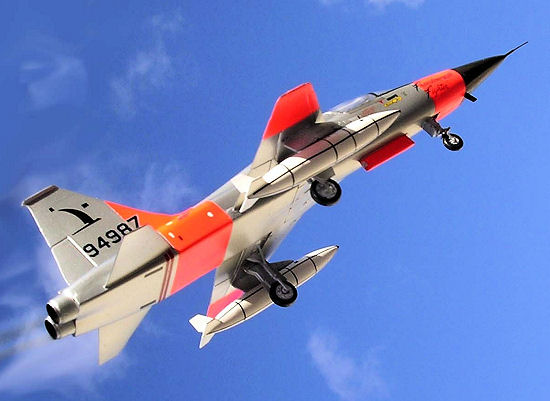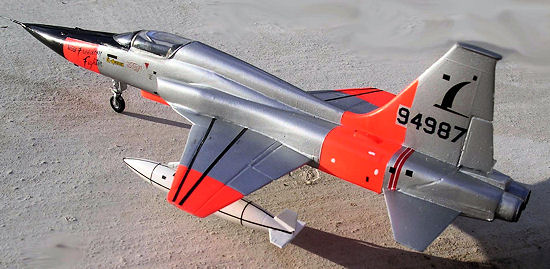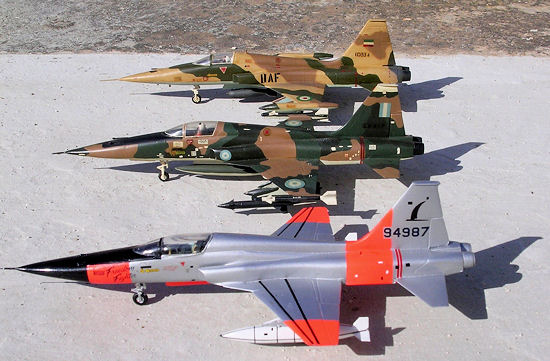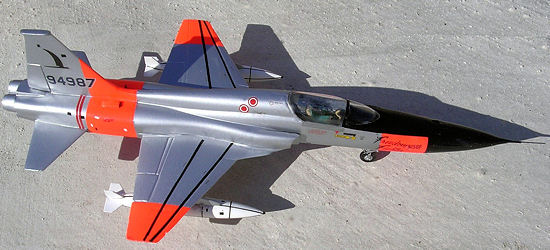
The F-5 was the outcome of a project
begun by Northrop with the aim of developing a small lightweight supersonic
fighter that would be substantially cheaper than its contemporaries of similar
performance. Construction of three N156Fs began in May 1958 as a private
venture, which was subsequently backed by the
US
Department of Defence. The first of these flew on July 30, 1959. Production
contract was placed for N-156s to be supplied as the F-5A and RF-5A single seat
and F-5B two-seat. The latter offers conversion training capability, under
mutual aid programme to the smaller nations militarily allied with the USA, to
countries as Nationalist China, Korea, Philippines, Thailand, South Vietnam,
Greece, Turkey, Netherlands, Spain, Norway among others.
 The
all-purpose fighter under the designation F-5A was powered two General Electric
J85-GE-13 turbojets. These rated at 3,050 lb.s.t. dry and 4,080 lb.s.t. with
afterburner. The first prototype was scheduled to join the test programme in
January 1963.The prototype undergone a number of tests adopted for the type in
various missions and the production aircraft being scheduled for completion by
summer of the same year. The N156F or F5A was to be the recipient of potentially
large orders as the F-84F Thunderjets, RF-84F Thunderflash and F86F Sabres
operated by NATO and SEATO air arms are phased out.
The
all-purpose fighter under the designation F-5A was powered two General Electric
J85-GE-13 turbojets. These rated at 3,050 lb.s.t. dry and 4,080 lb.s.t. with
afterburner. The first prototype was scheduled to join the test programme in
January 1963.The prototype undergone a number of tests adopted for the type in
various missions and the production aircraft being scheduled for completion by
summer of the same year. The N156F or F5A was to be the recipient of potentially
large orders as the F-84F Thunderjets, RF-84F Thunderflash and F86F Sabres
operated by NATO and SEATO air arms are phased out.
The
production version had seven external stores stations rather than the five
originally fitted. Back in those days the cost was reportedly to be £160,000 and
£216,000 according to equipment installed. Considerable effort was expected to
reduce maintenance time and cost. 25% of fuselage area was devoted to access
doors for the quick-release type, and were stressed than bolted doors are used.
These embodying small, easily removable access panels so that the line mechanic
can inspect, adjust and lubricate without removing main doors. The whole of rear
fuselage, including the tail plane is detachable to provide access for servicing
and removal of the engine.
More
improved versions continued to evolve. Among these, a version known as the
F-5-21 had up-rated engines and many new other features produced to the USAF
contract as the F-5E for American allies. An F-5B fitted with experimentally
with J85-GE-21s rated at 5,000 lb.s.t. was first flown on March 28th,
1969. It entered service with many countries and rendered stalwart service with
a good number of air forces that had the earlier version in service.
 A
somewhat primitive model when compared with the F-5 models of production version
released in later years by other kit manufacturers. However it is ideal for
producing a model of the prototype version of the F-5. Moulded in silver plastic
and issued with one decal set consisting of an F5A in service with the Imperial
Iranian Air Force pre 1980 era in an all metal finish. Decal was clearly printed
and of correct register. There are two, clear, very basic parts that form the
canopy, which is rather thick in section and of poor fit. Ejection seat was
replaced, as the one issued is far from what one should expect. Undercarriage
doors were also on the thick side in section and
I
needed to sand them down.
A
somewhat primitive model when compared with the F-5 models of production version
released in later years by other kit manufacturers. However it is ideal for
producing a model of the prototype version of the F-5. Moulded in silver plastic
and issued with one decal set consisting of an F5A in service with the Imperial
Iranian Air Force pre 1980 era in an all metal finish. Decal was clearly printed
and of correct register. There are two, clear, very basic parts that form the
canopy, which is rather thick in section and of poor fit. Ejection seat was
replaced, as the one issued is far from what one should expect. Undercarriage
doors were also on the thick side in section and
I
needed to sand them down.
Another
straightforward kit build. Trimming of fins from almost all items is the first
step forward and that is when the parts start to take their rightful shape.
There were parts that definitely needed replacement with others borrowed from
more recent F-5 kit releases. These include the nose and main wheels, wheel well
doors and detailed cockpit interior along with a more
 representative
ejection seat. Other detail made to the instrument panel and side console. Seat
belts were made from narrow strips of masking tape painted in light brown
colours. Nose pointed aerial replaced with a metal one. Two under wing tanks
were borrowed from those of another kit. These were modified having shortened
overall length and aft fins added.
representative
ejection seat. Other detail made to the instrument panel and side console. Seat
belts were made from narrow strips of masking tape painted in light brown
colours. Nose pointed aerial replaced with a metal one. Two under wing tanks
were borrowed from those of another kit. These were modified having shortened
overall length and aft fins added.
Fitting
the canopy required a small amount of filler, as there was a gap at the rear.
Under fuselage pylon was added from scrap piece of thick, shaped plastic card.
The wing pylons came from one found in Italeri kit. These were repositioned to a
station closer to the fuselage and are 12.5 mm from the wing tips. Other extra
work involved replacing the two nose guns with metal ones, Nose wheel well
opened and rebuilt deeper, scored panel lines at top and bottom of wings, and
added nose landed light which was engraved under forward fuselage. Engine
exhaust nozzles appear to be of correct size and were retained.
 I went
for the prototype version of the F-5 as I had the markings ready made on Micro
Scale decal sheet 72-104 Northrop F-5A ‘Asia’. The model was airbrushed in Model
Master silver. Only the nose cone and anti glare panel were black. Area at nose,
rear fuselage and wing tips were day glow orange. These had an undercoat of
white first. Central fuselage pylon was also day glow in accordance with a
colour picture that I had.
I went
for the prototype version of the F-5 as I had the markings ready made on Micro
Scale decal sheet 72-104 Northrop F-5A ‘Asia’. The model was airbrushed in Model
Master silver. Only the nose cone and anti glare panel were black. Area at nose,
rear fuselage and wing tips were day glow orange. These had an undercoat of
white first. Central fuselage pylon was also day glow in accordance with a
colour picture that I had.
Decals
that came from Micro Scale Adopted for the Northrop N156F consisted of the
legend ‘Freedom Fighter’, a tail motif that is in the shape of a scythe, which
then I figured it to be a ‘speed bird’, and the tail serial number. Some stencil
decals also came from same sheet.
The Prototype F-5 did not carry any USAF or star and bar
markings. These decals are over 30 years since when bought and to ensure these
did not break when immersed in water I have given them a coat of clear lacquer
and this worked 100%. A small silver decal was added to the back of tail serial
94987 at the portion that comes over the day glow area on the tail fin. The
danger stripes markings are kit decals. Black narrow stripes applied over wings
and white fuel tanks were cut from solid black decal using steel rule and a
sharp Exacto blade. An overall coat of Klear was applied and this sealed the
decals in place.
 I
always wanted to build the prototype version of the popular F-5 fighter ever
since I have seen a colour picture of it in a Flying Review issue dated 1960.
Micro Scale decal simplified matters, as it was the ideal decal for this model.
This was another colourful models coming from the mid 50s to late 60s era which
is meant to be the most colourful days ever for military aircraft types in my
opinion.
I
always wanted to build the prototype version of the popular F-5 fighter ever
since I have seen a colour picture of it in a Flying Review issue dated 1960.
Micro Scale decal simplified matters, as it was the ideal decal for this model.
This was another colourful models coming from the mid 50s to late 60s era which
is meant to be the most colourful days ever for military aircraft types in my
opinion.
Carmel J. Attard
January 2013
If you would like your product reviewed fairly and fairly quickly, please
contact
the editor
or see other details in the
Note to
Contributors.
Back to the Main Page
Back to the Review
Index Page
The
all-purpose fighter under the designation F-5A was powered two General Electric
J85-GE-13 turbojets. These rated at 3,050 lb.s.t. dry and 4,080 lb.s.t. with
afterburner. The first prototype was scheduled to join the test programme in
January 1963.The prototype undergone a number of tests adopted for the type in
various missions and the production aircraft being scheduled for completion by
summer of the same year. The N156F or F5A was to be the recipient of potentially
large orders as the F-84F Thunderjets, RF-84F Thunderflash and F86F Sabres
operated by NATO and SEATO air arms are phased out.
representative
ejection seat. Other detail made to the instrument panel and side console. Seat
belts were made from narrow strips of masking tape painted in light brown
colours. Nose pointed aerial replaced with a metal one. Two under wing tanks
were borrowed from those of another kit. These were modified having shortened
overall length and aft fins added.
I went
for the prototype version of the F-5 as I had the markings ready made on Micro
Scale decal sheet 72-104 Northrop F-5A ‘Asia’. The model was airbrushed in Model
Master silver. Only the nose cone and anti glare panel were black. Area at nose,
rear fuselage and wing tips were day glow orange. These had an undercoat of
white first. Central fuselage pylon was also day glow in accordance with a
colour picture that I had.